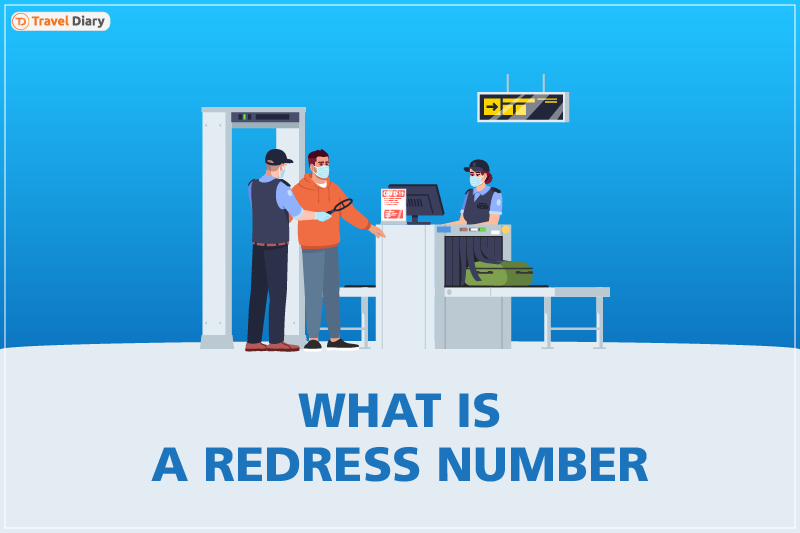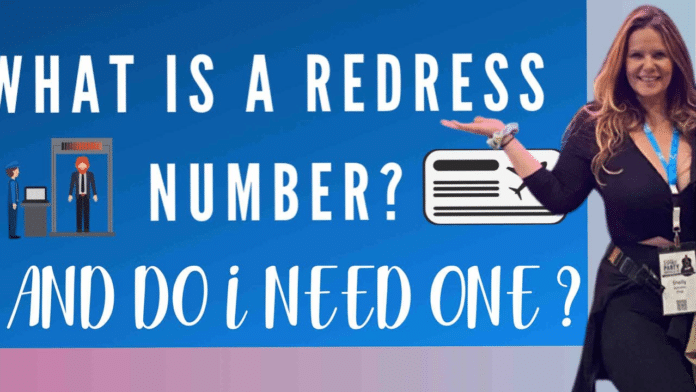Ever asked the question, what is a redress number? Well, it’s not a number wearing a dress.

In today’s interconnected world, consumers frequently face situations where they must find solutions to various problems they encounter.
Whether it’s a defective product, inadequate customer service, or an unsatisfactory experience, it is crucial to have a streamlined approach to resolving these issues. This is where the concept of a “redress number” becomes relevant.
Related: Common Computer Issues and How to Fix Them
Redress Number Meaning?

A redress number is a unique seven-digit identifier issued by the Transportation Security Administration’s (TSA) Secure Flight program to match travellers with the results of their redress case through the DHS TRIP program.
The DHS TRIP (Travel Redress Inquiry Program) is a program that allows travellers who have been mistakenly identified as a security threat to request a redress number. This number can be used to help prevent future problems at airports and other transportation hubs.
Suppose you have been denied boarding, delayed, or subjected to additional screening because you were mistakenly matched to a name on a watch list. In that case, you may be eligible for a redress number. You can apply for a redress number online at the DHS TRIP website.
Once you have been issued a redress number, you should provide it to airlines and other transportation entities when you make travel reservations. This will help to ensure that you are not subjected to unnecessary screening in the future.
Related: Receiptify: How to get Spotify Music Receipt
Why Do You Need a Redress Number?

You may need a redress number if you have been mistakenly identified as a security threat and have experienced problems at airports or other transportation hubs, such as:
- Being denied boarding
- Being delayed
- Being subjected to additional screening
A redress number can be used to help prevent unforeseen problems. When you provide your redress number to airlines and other transportation entities, it will help them to identify you as someone who has been cleared by the government and is not a security threat.
This can help expedite the travel screening process and reduce the additional screening you are subjected to.
Related: How to Check Glo Number
Redress Number Generation Process

The Redress Number Generation Process is a system used by various governments, particularly the United States, to provide a means of redress or resolution for individuals who have encountered difficulties or inconveniences related to travel and security measures.
The Redress Number aims to help these individuals avoid recurring issues during future travel.
The process begins when an individual believes they have experienced problems such as being consistently selected for additional security screening at airports or facing difficulties with visa applications.
They can then submit a request for redress to the relevant government agency, typically the Department of Homeland Security (DHS) in the case of the United States.
The individual must go through a specific procedure to generate a Redress Number. This typically involves completing an application form, which can often be done online, and providing detailed information about their past travel experiences and any related issues encountered.
The information required may include personal details, such as full name, date of birth, and passport information.
Once the application is submitted, the government agency responsible for handling redress requests will review the information provided. They may verify the individual’s identity and investigate the reported issues to ensure their validity. This process can take some time, as the agency needs to conduct a thorough assessment.
After the review process, a Redress Number will be generated if the agency determines that the individual is eligible for redress. This number serves as a unique identifier for the individual within the agency’s system.
It helps airport security personnel and other relevant authorities to identify the person as someone who has gone through the redress process and may be subject to certain screening procedures or accommodations.
The Redress Number is typically communicated to the applicant through secure channels, such as email or postal mail. Individuals need to keep their Redress Number in a safe place and provide it whenever they make travel arrangements or encounter any issues related to travel or security.
Related: How to Lookup Your License Plate Number
How To Apply For A Redress Number

Here are the steps on how to apply for a redress number:
- Go to the DHS TRIP website: https://www.dhs.gov/dhs-trip
- Click on the “Apply for Redress” button.
- Create an account or sign in to your existing account.
- Complete the Redress Inquiry Form.
- Upload any supporting documentation.
- Submit your application.
The Redress Inquiry Form asks for the following information:
- Your name, date of birth, and gender
- Your address and contact information
- Your travel history, including any incidents where you were denied boarding, delayed, or subjected to additional screening
- Any other information that you believe is relevant to your application
- You can upload supporting documentation, such as copies of your passport, driver’s license, or other identification documents.
Once you have submitted your application, DHS TRIP will review it and issue a decision within 30 business days. If your application is approved, you will be issued a redress number. You can use this number to track your application’s status and provide it to airlines and other transportation entities when you make travel reservations.
Related: How to Hide Number on MTN
Required Documentation and Application Process for Getting a Redress Number

Here is the required documentation and application process for getting a redress number:
1. Required Documentation
- A copy of your government-issued photo ID, such as a passport, driver’s license, or military ID.
- If you are a U.S. citizen, you must also provide a copy of your birth certificate or naturalization certificate.
- If you are not a U.S. citizen, you must also provide a copy of your visa or other immigration documentation.
2. Application Process
You can apply for a redress number online at the DHS TRIP website. See above for details.
The application process is free and simple. You will need to create an account and provide the required documentation. You will also need to answer a few questions about your travel history and any incidents where you were denied boarding, delayed, or subjected to additional screening.
Related: How to check Airtel number
Tracking and Monitoring Redress Numbers

Tracking and monitoring redress numbers is an important aspect of many systems and processes, particularly those related to customer service, dispute resolution, and grievance handling. Here we discuss the significance of tracking and monitoring redress numbers and how they contribute to effective problem resolution.
1. Case Management
Redress numbers serve as a reference point for organizing and managing individual cases. Organizations can easily track and locate specific cases in their system by assigning a unique identifier to each case. This facilitates efficient case management, enabling staff members to quickly access case details, update information, and provide timely assistance.
2. Progress Tracking
Redress numbers help monitor the progress of a case from initiation to resolution. By regularly updating the case status associated with a redress number, organizations can keep stakeholders informed about progress, ensuring transparency and accountability.
This tracking mechanism lets the organization and the customer stay updated on the case’s status and any actions taken.
3. Performance Evaluation
Monitoring redress numbers provides valuable data for performance evaluation. Organizations can assess their efficiency in handling redress requests by analyzing the number of cases received, resolved, and pending.
This data can help identify bottlenecks, areas for improvement, and patterns in customer complaints, enabling organizations to refine their processes and enhance customer satisfaction.
4. Trend Analysis
Tracking and monitoring redress numbers over time can reveal patterns and trends in customer grievances or disputes. Organizations can identify recurring issues, systemic problems, or areas requiring policy changes by categorising cases and analysing the data associated with redress numbers.
This insight empowers organizations to address underlying causes, implement preventive measures, and reduce redress cases.
5. Compliance and Legal Requirements
In some industries, tracking and monitoring redress numbers are essential for compliance and legal purposes. Regulatory bodies may require organizations to maintain records of redress cases and their outcomes, ensuring adherence to industry regulations. Redress numbers provide a systematic and auditable way of meeting these requirements.
6. Customer Service and Satisfaction
Redress numbers contribute to effective customer service by enabling prompt and accurate responses to customer inquiries. When customers inquire about the status of their case, customer service representatives can easily locate and provide real-time updates based on the associated redress number.
This improves customer satisfaction by demonstrating the organization’s commitment to resolving their concerns.
Related: Kuda Customer Care Number
Tips For a Successful Redress Number Application
- Ensure you have all the required documentation before you start the application process.
- Be as detailed as possible when describing your travel history and any incidents where you were denied boarding, delayed, or subjected to additional screening.
- If you have an attorney or other representative who is helping you with your application, be sure to include their contact information.
- Keep a copy of your application and all supporting documentation for your records.
Related:
- Spotify Stats: How to check your Stats on Spotify
- Counter.wmail-service.com: 6 Easy Ways to Remove The Virus
- CDN AF FEEDNEWS.COM: All you need to know about the Content Delivery Network
FAQs
Where is the redress number on the passport?
The redress number is not on a passport. It is a unique seven-digit number issued by the Transportation Security Administration (TSA) to identify travellers who have been mistakenly identified as a security threat. You can find your redress number in your confirmation email after applying for one.
What is a redress number, and how do I get one?
A redress number is a unique seven-digit number issued by the Department of Homeland Security (DHS) to identify travellers who have been mistakenly identified as a security threat. If you have been denied boarding, delayed, or subjected to additional screening at an airport because your name matches that of someone on a watch list, you may be eligible for a redress number.
To apply for a redress number, you can do so online at the DHS TRIP website (https://www.dhs.gov/dhs-trip). The application process is free and simple. You will need to provide some basic information about yourself, such as your name, date of birth, and address. You will also need to provide a copy of your government-issued ID.
Once you have submitted your application, DHS TRIP will review it and issue a decision within 30 business days. If your application is approved, you will be issued a redress number. You can use this number to track your application’s status and provide it to airlines and other transportation entities when you make travel reservations.
Is a redress number the same as a known traveller number?
No, a redress number is not the same as a known traveller. A redress number is issued to travellers who have been mistakenly identified as a security threat, while a known traveller number is issued to travellers who have been pre-approved for expedited screening through programs like TSA PreCheck or Global Entry.
Conclusion
Redress numbers provide a valuable mechanism for simplifying the process of complaint resolution.
Organizations can effectively track and address consumer grievances by assigning a unique identifier to each complaint, leading to improved customer satisfaction. Redress numbers streamline the complaint-handling process, empower consumers, and facilitate data analysis for quality improvement.
As technology continues to advance, we can expect further enhancements and integration of redress numbers in various industries, ensuring a seamless resolution experience for all.
If there are any questions, post them below.





